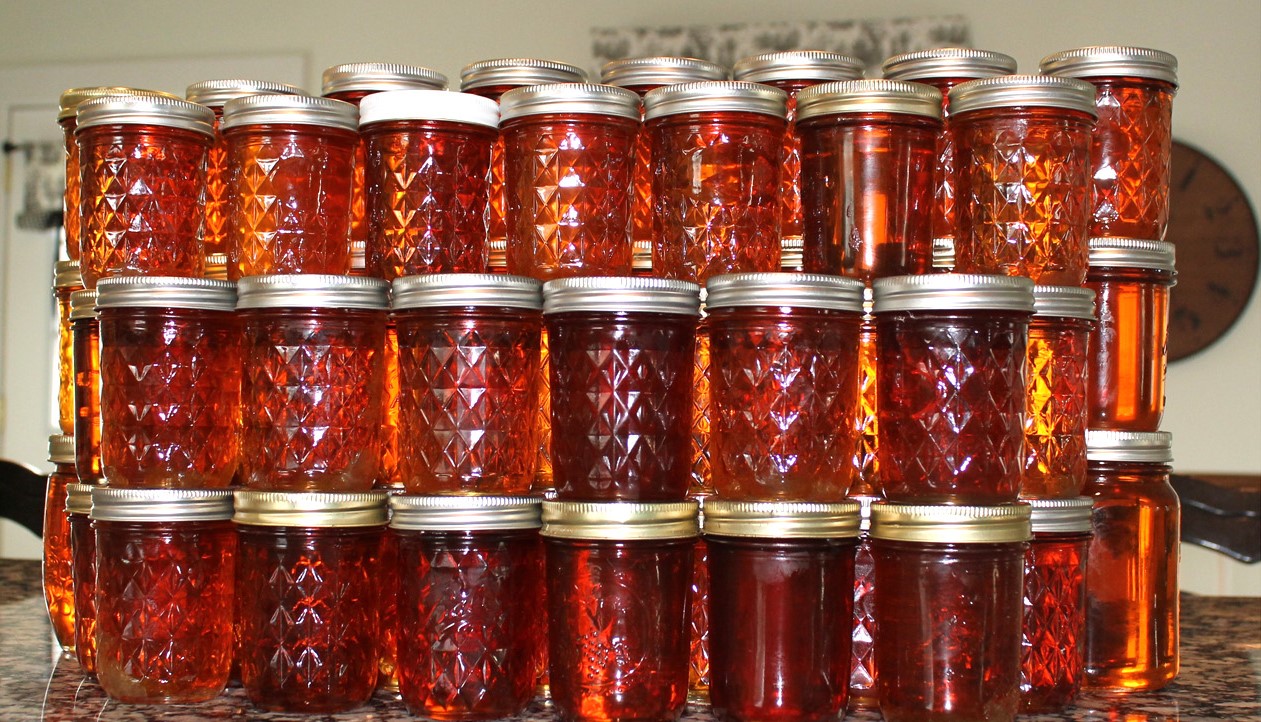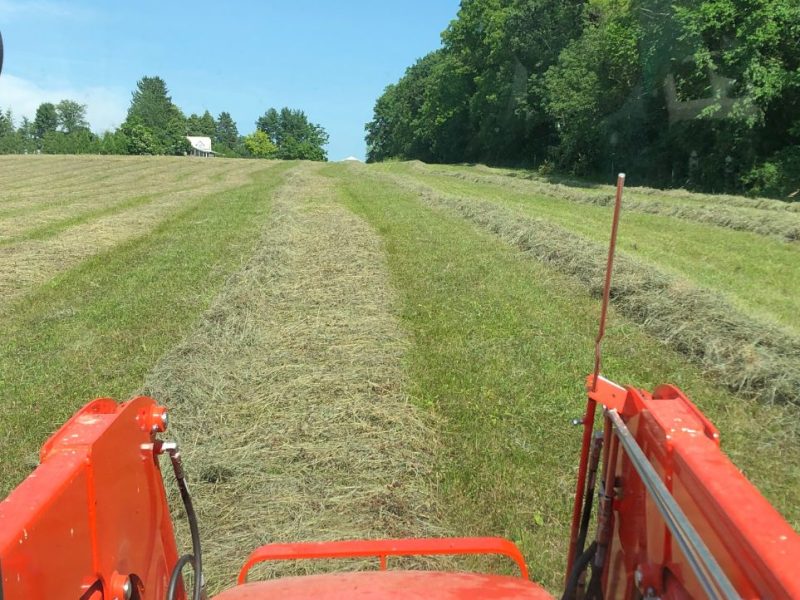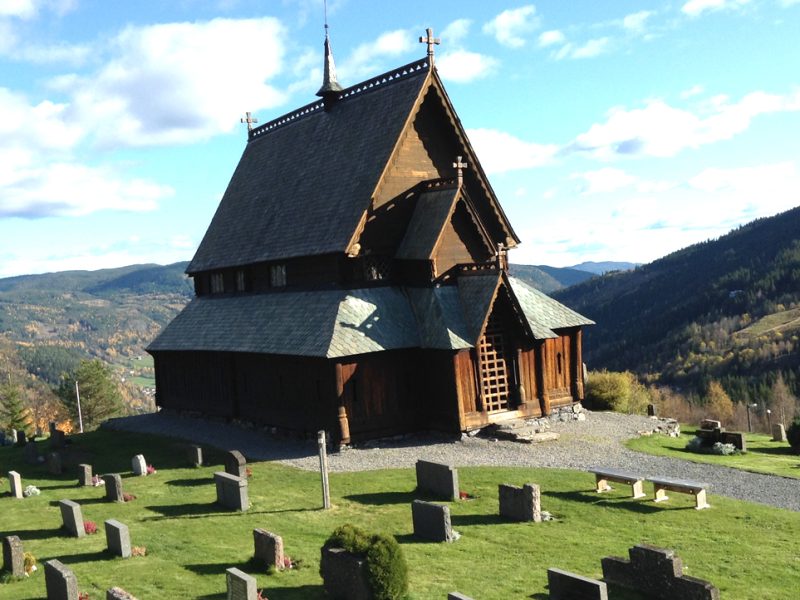Nearly four gallons of pure maple syrup gathered in one season by the Fryer family of Chatfield. (Photo by Julie Fryer)
A Sweet Surprise in Your Own Backyard
Collecting Maple Syrup is a family tradition at this home.
CHATFIELD — Minnesota has a sweet story to tell and right here in the Driftless area, as the temperatures rise, flowing taps and buckets soon appear on trees along boulevards and country roads. During those few short weeks in early spring, when it’s not too hot and not too cold, sugarmakers will gather gallons and gallons of sap to boil down into pure maple syrup.
The hobby has seen a resurgence in recent years and it’s easy to see why. With some time, patience, and the right weather, anyone can gather enough syrup to last an entire year. It’s a fun family activity that gets everyone outside and can even turn into a small business opportunity at local farmers’ markets.
But this age-old first harvest is more than a hobby. It’s a signal for spring to return and a reason to gather as a community. And now as our climate changes, it’s a warning that we need to pay attention to nature.
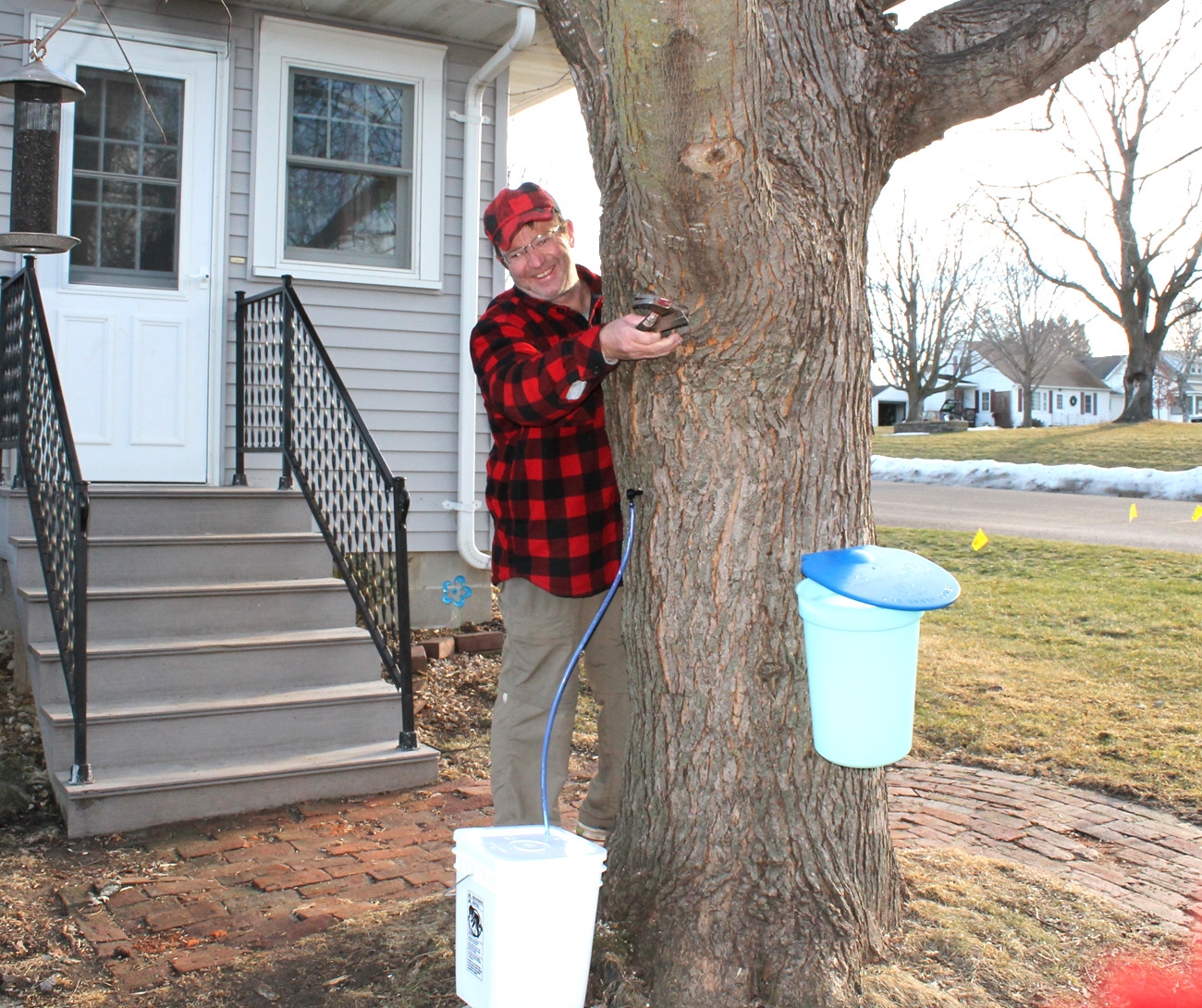
Pete Fryer tapping trees in their Chatfield backyard. (Photo by Julie Fryer)
Four Gallons and a Fire Alarm
Our family has made maple syrup for about 10 years. We started with a few boils at my in-laws’ home near Lanesboro and, for the past 7 years, we’ve continued here at our home in Chatfield. Each year we tap two maple trees in our own yard and six to eight more trees in our neighbors’ yards. This has led to some interesting conversations and I’ve learned to keep a stack of disposable cups on hand because every child (and some adults) wants to taste the sap right out of the tree. The youngest visitors usually come back for seconds!
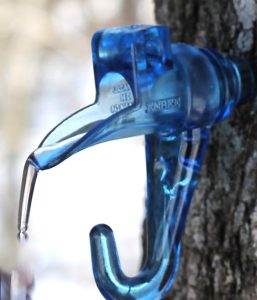
Sap running out of the tree on a warm spring day. (Photo by Julie Fryer)
We’ve also learned that you do not need an acreage to make plenty of maple syrup. All of my sap comes from my own or my neighbors’ trees, all in Chatfield city limits.
And in fact, boulevard or city trees have higher sugar content than forest-grown trees because they do not have to compete with each other for resources. And higher sugar content means less boiling time which is the ultimate sugarmaking win.
Tapping does not hurt the tree as long as it’s healthy when you tap it. The hole will quickly heal and within one year should completely fill back in. You just cannot tap that same spot again next season.
We cook our syrup outside on our corner patio which attracts a lot of attention including cars stopping in their tracks to see what’s going on.
The first year we boiled, we even had a visit from the neighbor convinced our house was on fire because of the billowing steam. Folks walking by will inevitably stop to investigate and usually bring back a friend to show them our operation.
For us, this community connection is really the best part of sugarmaking. People slow down and pay attention to nature; learn that real maple syrup does not come from a plastic bottle; and probably most importantly, see that harvesting your own food really isn’t that difficult.
The Bigger Change in Seasons
When you’re this close to nature and planning your entire schedule around the thermometer, you become attuned to the subtle changes in nature. And over the past five years, those changes have become impossible to ignore. So much so, that we can’t really say anymore that March is “normal” tapping season.
Three out of the last five years, the early warm up in January has started the season two months early. That, combined with erratic freeze/thaw cycles, has reduced the sap output and this year severely affected the bigger maple tapping industry across North America. Canada recently announced that its maple syrup reserve (yes, they keep a reserve) is at a 16-year low and sits at less than 10% of its capacity.
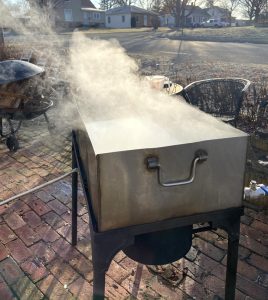
A full pan of sap slowly steaming away the water on a spring day. (Photo courtesy of Julie Fryer)
While a “strategic maple syrup reserve” is fodder for late night comedians, this now regular disruption of the maple syrup season is truly the canary in the coal mine.
Indigenous peoples consider maple trees one of their most important natural family members. They are the first to wake up in the spring, they are the first to provide sustenance and community, and they continue to provide for other needs such as shelter and aesthetic beauty.
And now they are showing us that the climate is changing. Many Northeastern tribes this spring decided to not tap at all because of the stress the trees were already under from early thaw and last year’s drought.
How Is Maple Syrup Made
Preserving the tradition of making maple syrup is even more important with these changes we’re facing. And teaching the next generation is key to awareness.
Many local nature and learning centers host Sugaring Weekends including Eagle Bluff Environmental Learning Center, Whitewater State Park, and Quarry Hill Nature Center. These are usually held in February or March and, even if the season comes early, they can show you the process from tapping to boiling.
Learning yourself is also very doable and it does not require expensive or complicated equipment. Most local home stores sell spiles and tubing and you can find lots of options online or through local market groups. And the community loves to help beginners, so don’t be afraid to ask for help!
While the equipment has been modernized, the path from tree to table has not changed in hundreds of years. The season cannot be rushed or made to last longer than Mother Nature intends. That’s why sugarmakers are often like surfers – just waiting for that perfect temperature wave and ready to drop everything to fire up the cooker. The season is short but sweet and we’re not going to miss it!
Here are the basics on what sugarmaking looks like:
Watch the Temperature. The sap starts to run when the daytime temperatures climb into the 40°s F but the nighttime temperatures fall back below freezing. This cycle creates a pressure imbalance and the sap starts to move up and down the tree. If the tree is tapped, a small amount of the sap will flow out through the spile or tubing and into the bucket. Once the temperatures stay consistently above freezing and the tree starts to bud out, the tapping season is over because this gives the sap an off or “buddy” flavor.

Seventeen gallons of sap is reduced down to a sauce pan for the final boil, awaiting the magic temperature of 219°F. (Photo by Julie Fryer)
Collect the Sap and Evaporate the Water. Each little drip quickly turns into full buckets which we empty daily. Sap can be frozen or kept cold until you have enough to boil. Pure maple syrup is just that, pure. Nothing is added during the process and the finished product is simply the caramelized sugary liquid left after all the water is evaporated.
Most trees put out sap that is around 40-to-1 water which means for every 40 gallons of sap collected, you will end up with 1 gallon of syrup. It takes a lot of evaporation to get rid of that water.
Spend any time with sugarmakers and you’ll quickly learn they are the ultimate DIYers. Every possible contraption has been created to collect and boil this liquid gold. And most of it was made for free out of spare parts or hand-me-downs. If it creates evaporation and doesn’t blow up, it’s likely good enough to boil maple syrup.
The pan I use holds about 17 gallons of sap and I typically start my boil at around 7:00 a.m. After a few hours, I’ll add more warmed up sap and will do this over the course of the day until I’ve poured in a total of about 25 gallons of sap. By about 6:00 p.m., it’s boiled down enough to pull out of the big pan and finish boiling in a smaller kettle which takes another hour or so.
Of course, every operation is different and you can buy expensive and complex equipment for warming, boiling, and finishing maple syrup. Many small backyard sugarmakers use gas cookers (like we do) for convenience and timing. But the more traditional folks use wood which can give a smokier, more caramelized flavor.
You can cook in batches, saving the reduced sap to cook all at once. You can let the sap freeze and throw out the chunks of ice because they’re mostly water. If you want to get really fancy, you can build or buy a reverse osmosis system to speed up the process. In the end, you’re going to have to boil it and you might as well plan on sitting by the pan and enjoying the day.
Watch the Temperature (Again) and Get Ready to Bottle. Finally, you’ve boiled it and boiled it some more! Now what? Much like making candy, you’ll need a good thermometer. Once your syrup gets to 219° F, it’s done. From there, most folks filter syrup (but this is not essential for home use) and put it directly into canning jars or bottles, tip the jars upside down to flood the seal, and let them rest on their sides for 24 hours. From here the jars should seal (listen for the pop) and you’re done.
Pure maple syrup will keep indefinitely if sealed correctly and boiled to the proper temperature. Once opened, it should be refrigerated. Like honey, pure maple syrup has amazing nutrients and health benefits and can be used in place of white, refined sugar in nearly every recipe.

Pure maple syrup poured over a fresh stack of pancakes. Yum!! (Photo by Julie Fryer)
More Than Pancakes
One thing we can guarantee – once you’ve made your own pure maple syrup, you will never go back to store bought. And your friends and family will be expecting a jar in every gift basket.
But that is the true joy in becoming a sugarmaker! You get the fun of being in nature and of magically turning water into a sweet gift that everyone loves. In the process, you’ve slowed down, savored the beauty of the world around you, and hopefully taught a kid or two that they can do this too.
The journey from tree to table is as sweet as the syrup itself.
…………………

Contributor
Julie Fryer is the author of the book, Guide to Maple Tapping: A Tree to Table Handbook for the Maple Tapper, which can be found online and at local bookstores. She has also worked with a small Midwestern company, Maple Tapper, to develop a line of sugarmaking equipment designed for small-batch backyard sugarmakers.


